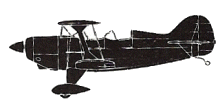
ASN Wikibase Occurrence # 292583
This information is added by users of ASN. Neither ASN nor the Flight Safety Foundation are responsible for the completeness or correctness of this information.
If you feel this information is incomplete or incorrect, you can submit corrected information.
| Date: | Sunday 5 March 2006 |
| Time: | 14:15 LT |
| Type: |  Aviat Pitts S-2B |
| Owner/operator: | Private |
| Registration: | N221RS |
| MSN: | 5318 |
| Total airframe hrs: | 810 hours |
| Engine model: | Lycoming AEIO-540-D4A5 |
| Fatalities: | Fatalities: 0 / Occupants: 2 |
| Aircraft damage: | Substantial |
| Category: | Accident |
| Location: | Severance, Colorado -
 United States of America United States of America
|
| Phase: | Unknown |
| Nature: | Private |
| Departure airport: | Fort Collins/Loveland-Northern Colorado Regional Airport, CO (FNL/KFNL) |
| Fort Collins/Loveland-Northern Colorado Regional Airport, CO (FNL/KFNL) | |
| Investigating agency: | NTSB |
| Confidence Rating: |
The airplane's main 23-gallon fuel tank was serviced to capacity. The pilot flew one passenger for about 30 minutes, returned to the airport, dropped off the passenger, boarded a second passenger, and took off again. They had been flying for about the same period of time when the engine suddenly began to run rough, then lost power. He made a forced landing in an open field. During the landing roll, the airplane nosed over, crushing the vertical stabilizer and breaking a rib in the upper left wing. The digital fuel flow gauge indicated 15.5 gallons of fuel had been consumed, and 7.5 gallons remained. Some fuel was leaking from the tank. The pilot said it looked and smelled like kerosene. The fixed base operator (FBO) was notified and fuel that had been sumped that day from the fuel trucks and fuel farm were quarantined. The salvage crew that recovered the airplane said it appeared the fuel may have mixed with smoke oil, giving the appearance and smell of kerosene. The airplane was equipped with a smoke-generating system. Neither the fuel nor smoke oil tanks had been compromised. All supply lines were intact and securely fastened. Less than a quart of fuel was recovered from the fuel tank. Thirteen jars of fuel that had been sumped from the FBO's fuel trucks and from the fuel farm were retrieved and examined. They were all clear, blue (similar to 100-LL), and appeared to be free of contaminants. According to the manufacturer, the engine will burn 17.4 gallons per hour (gph) at 75 percent power which is 195 horsepower (hp) or 2,450 revolutions per minute (rpm), when leaned for best power. At full (100 percent) power, or 260 hp and 2,700 rpm, the engine will burn 21.5 gph. The pilot subsequently submitted a statement, indicating he had "run out of gas."
Probable Cause: fuel exhaustion and the pilot's failure to refuel the airplane. Contributing factors were the inaccurate fuel flow reading and the pilot's incorrect fuel consumption calculations.
Accident investigation:
 |
|
Sources:
NTSB DEN06LA046
Revision history:
| Date/time | Contributor | Updates |
|---|---|---|
| 09-Oct-2022 06:32 | ASN Update Bot | Added |
Corrections or additions? ... Edit this accident description
The Aviation Safety Network is an exclusive service provided by:


 ©2024 Flight Safety Foundation
©2024 Flight Safety Foundation